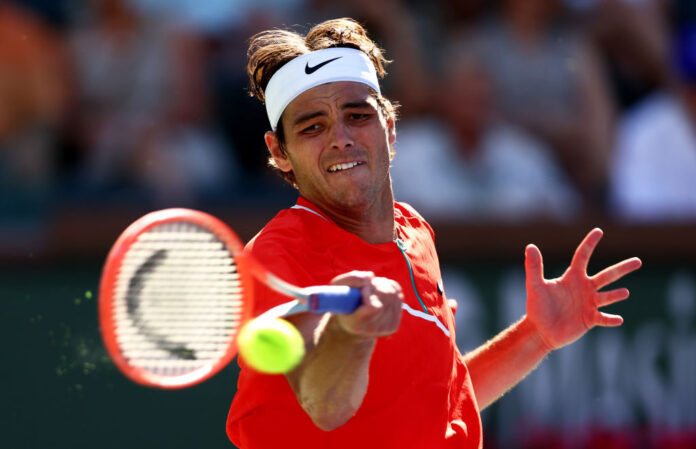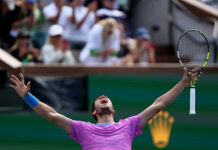Bill Simons
Indian Wells
RAFA TOPPLES ANOTHER AMERICAN: Rafa Nadal is a kind warrior. He says he likes America. But he certainly doesn’t act that way. Since the start of the year he’s 18-0 – he’s breezed past seven Americans: Max Cressy, Marcos Giron, Denis Kudla, Stefan Kozlov, Tommy Paul, Seb Korda and Reilly Opelka (plus USC product Yannick Hanfmann).
Then again, Rafa Nadal has subdued everyone he’s faced this year: crafty lefties like Cam Norrie, Denis Shapovalov, Adrian Mannarino and Dan Evans, a guy who named his cat after Rafa, Seb Korda, a fellow with two first names, Tommy Paul, and a man whose name means “bear” in Russian – Daniil Medvedev.
Rafa’s foot may be hurting. Today he felt the pain. “So-so,” he sighed. “Then on the second set, a little bit worse, being honest. I felt my foot…in the second set. I was able to keep running…Something can happen – we know that. Just try to be ready and stay positive because [this is] going to be my last tournament on hard.”
One of his team members said, “The foot may not be perfect, but we are here to fight.” Today Rafa had a big fight on his hands. Reilly Opelka is seven feet tall. His serve and forehand are bolts. Rafa stood near the stands, yet still struggled to muscle back the American’s high-bouncing serves.
But deep into the first set tiebreak, Reilly netted two forehands to give Nadal the first-set tiebreak 7-3. But then Opelka broke in the second set and had three break points to go up 5-2. “What is going on here, from a Nadal point of view?” asked Brett Haber. “This is crazy.” Yes, Novak Djokovic has the leading record for breaking serves on hard courts, but, overall, Rafa is the ATP leader in breaking serves. Today, at crunch time in the hot sun, he cooled off Opelka to prevail on his third match point 7-6(3), 7-6(5). He said it was the best match he’s played this year.
We asked him how come he’s so clutch under pressure? He began, “I don’t know. It’s important to know yourself, to know the things you have more control of, and in pressure moments play with these shots that you feel more confident with, no?
“In terms of holding up under pressure, there are different facts. First is the confidence. Depending on the momentum, you play better. When you are confident, you are winning matches, you feel more relaxed. It’s easier to play…no?
“Another thing is practice. During all my life I practiced with very high intensity. I take every single practice like a professional match. I put myself in that position almost every single day of my life since I was a kid.”
The undefeated Rafa hasn’t been kidding this year. Only Novak Djokovic had better starts to the year. Next, Rafa will play Nick Kyrgios, who famously emerged on the scene when he shocked Rafa at Wimbledon eight years ago. Now Rafa has a 5-3 winning record against the Aussie. The two have a dicey history. After a dust up in Mexico a while back, Nadal said Nick “lacks respect for the public, the rival and towards himself.”
VIVA LA DIFFERENCE: Rafa bites trophies after he wins. Krygios bites towels during matches.
COURIER’S TAKES: Jim Courier has provided many an interesting insight on players at Indian Wells. He called Adrian Mannarino’s forehand “the most knuckler of shots on the tour.” To him, Brandon Nakashima’s great two-handed backhand is “ATM.” When Nadal is broken, the intense Rafa “sits on top of break point mountain.” Tsitsipas’ backhand “kicks like a mule.” Courier noted that Seb Korda’s cat was named Rafa and observed, “It’s hard to take the gee whiz out of Rafa, when you named your cat after him.” As for Daniil Medvedev’s loss to Gael Monfils, Courier said, “I have to believe something has to do with these external pressures [relating to Russia’s invasion]”…And then he noted the obvious: “You’re not going to get a lob over Opelka’s head.”
THE LONG AND WINDING TIEBREAK ROAD: Jimmy Van Alen, the classic tennis showman and creator of the original tiebreaker, hoisted his red flag in 1965 at his home tournament at the Newport Casino, signaling a nine-point sudden-death tiebreaker (first to five points) when the score reached six games all. The game would never be the same.
In 1970, US Open tournament director Billy Talbert decided to adopt sudden-death scoring in a Grand Slam match and for the next five years red flags were raised whenever the score was knotted at six games all. Since 1975, the 13-point tiebreaker (first to seven points, win by two) has been used for all sets at the US Open, including the fifth and deciding set.
If the tiebreaker had been in place there would never have been Pancho Gonzalez’ 22-24, 1-6, 16-14, 6-3, 11-9 Wimbledon win over Charlie Passarell or the 18-16 classic Wimbledon tiebreak battle between Bjorn Borg and John McEnroe in 1980. And John Isner would never having gone down in history as playing in the longest pro match in history against Nicolas Mahut, finally prevailing 70-68 in a match that took three days in 2010.
But, of late, things have gotten confusing. All four slams have had different ways of deciding the final set. The Grand Slam Board announced that a new trial format for the final set at all four majors with a first-to-10-point tiebreak at 6-6 will start this year at Roland Garros. The Australian Open was the first to use this format, while the French Open kept a standard first-to-two-games-ahead for a match to end. Wimbledon created a hybrid: the first to-seven win-by-two, but only at 12-games all. The US Open has long used first-to-seven-point standard tiebreaks at 6-6 in the final set.
While Rafa Nadal was rather indifferent to the change, Taylor Fritz said, “It’s more exciting probably for the fans to be able to see…[the new] match tiebreaker. But I will kind of miss seeing players at 20-20 or 14-14 in the fifth. That’s just an absolute battle.
“It does suck for those players, because you’re so done for your next match. But it’s tradition, and I’ll miss seeing those crazy battles…If I find myself in one of those in the future I’ll be pretty happy that they have that rule.”
QUOTE OF THE DAY: “There are few taller tasks than breaking this man.” – Brett Huber on Reilly Opelka.
FRITZ’ FLURRY: Fritz Taylor is doing it again. A second consecutive win in a third-set tiebreak took Taylor Fritz into the Indian Wells quarterfinals, as another tiebreak had last October. Despite a slow start and some problematic overheads, he scored a gritty win over Australian Alex DeMinaur 3-6, 6-4, 7-6 (5) and next will face Serbian Miomir Kecmanovic, who downed Matteo Berrettini in three sets. Speaking of the pressure matches, Fritz commented, “I’ll choke some matches here and there, for sure. A lot of people do. But then I’ll also clutch out a lot of matches, like I have the last two days. The last two third-set breakers I played have been really solid – not a lot I did wrong in either one.”
ASIA IS THE LAST AMERICAN WOMAN: Iga Swiatek said it was boring to lose the first set of her matches and then have to come back. She vowed that, unlike her first three matches, that wouldn’t happen in her next match. Tonight she dismissed Aussie Open quarterfinalist Madison Keys 6-1, 6-0 in 56 minutes. Las Vegas resident Asia Muhammad, who is through to the women’s doubles semis with Japan’s Ena Shibahara, is the last American woman in the draw. Taylor Fritz is still in the men’s singles. John Isner and Jack Sock are rocking it and are still in the doubles.
NOT A FAN: Grigor Dimitrov said he likes the changing conditions at Indian Wells, “It’s tricky, but it keeps you focused.” Reilly Opelka admitted Indian Wells is not his favorite place. “Sometimes it just is crazy – windy and super cold. The ball is ridiculously slow…It’s not my favorite place to watch tennis. You don’t see enough risk.”
BROOKSBY DERAILED: Defending champion Cam Norrie beat Jenson Brooksby 6-2, 6-4 to end the 21-year-old’s Indian Wells run.
COVID HAIRSTYLES PLUS AGING EQUALS: Feliciano Lopez, 40, has a beautiful gray beard.



















